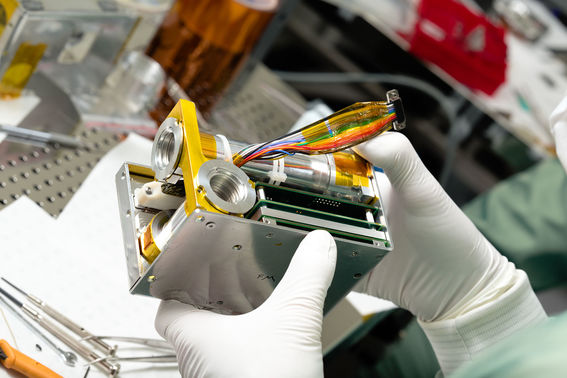Towards more sustainable space research – The Foresail-1 satellite will be launched in spring 2022

Aalto University has signed a contract to launch the Foresail-1 satellite. The satellite has been built as part of the Finnish Centre of Excellence in Research of Sustainable Space, which is funded by the Academy of Finland, and is run by the University of Helsinki in cooperation with Aalto University, the University of Turku, and the Finnish Meteorological Institute.
The Centre of Excellence studies space conditions and, on the basis of the research, develops more sustainable satellites that will not turn into space debris in Earth's orbits.
The Foresail-1 satellite will carry with it two major scientific instruments developed by the Centre of Excellence - the PATE particle telescope, which will study the near-Earth radiation environment, and a plasma brake which will be used to test bringing spacecraft back into the atmosphere.
“The Centre of Excellence brings together Finland's leading experts in space science and technology. With the long-term funding from the Academy of Finland, we have created Finland’s first scientific space programme. The goal for the future is to safeguard Earth's orbits with state-of-the-art research and to revolutionise experimental space physics with the help of nanosatellites,” says Professor Minna Palmroth, Head of the Centre of Excellence at the University of Helsinki.
The satellite launch contract was signed with the German company EXOLaunch, which coordinates the launch sites of the US company SpaceX.
“In addition to Foresail-1, the Falcon 9 rocket will carry several other small nanosatellites. The rocket will be launched into orbit at an altitude of about 550 kilometres in late spring 2022. More detailed information on the timing of the launch will be available during the spring. The Foresail-1 team, which is currently made up of professionals and students, is focusing on integrating the instruments into the satellite and the final tests, which will take place in January,” says Assistant Professor Jaan Praks from Aalto University.
PATE investigates space radiation
The goal of the Foresail-1 satellite is to take the understanding of the radiation environment in space to a new level. This knowledge will help develop nanosatellites that are radiation-tolerant and last longer in space.
“The relativistic electrons in the radiation zones are especially dangerous for satellites, because their intensities vary enormously over time, which is the result of different particle acceleration and loss mechanisms,” says Professor Rami Vainio from the University of Turku.
Our planet Earth is surrounded by two distinct high-intensity radiation zones. The inner zone has protons and the outer zone has electrons. The proton zone is relatively stable, but the electron zone is in constant turmoil as Earth’s magnetic field, which traps particles further from the planet, is much more susceptible to solar wind disturbances.
“The goal of the PATE instrument is to find out more precisely than before how electrons exit the radiation zones into the atmosphere,” Vainio says.
The plasma brake helps to destroy the satellite in the atmosphere
Even the most durable nanosatellite will not last forever. A decommissioned nanosatellite can take years to sink into the atmosphere where it burns up. The Finnish Meteorological Institute has developed a plasma brake that would allow the satellite to be guided into the atmosphere in as little as two months. The plasma brake has already been tested in the Aalto-1 student satellite that was launched in 2017, and now its operation has been developed to be even more reliable.
“The plasma brake works in theory, but the braking force of the plasma brake has not yet been measured in space,” says Pekka Janhunen, Research manager at the Finnish Meteorological Institute.
"After opening the long tether reel of the plasma brake, a tension is applied to the tether and the resulting braking force is measured. The result will enable us to calculate how long a plasma brake tether needs to be if the satellite is to be brought down in a certain time and its mass and orbital height are known,” says Janhunen about the development of the plasma brake.
Plasma brake technology can also be used to lower the satellite's orbital track by the desired amount.
"In particular, research and weather satellites normally operate in a solar synchronous orbit at an altitude of about 600 to 800 kilometres. The rotation of the orbital track with respect to the sun remains in place and thus the satellite orbits the earth daily under the same light conditions. After lowering the satellite's orbital altitude, the satellite can make overflights at different times of the day,” says Janhunen.
Further information:
Minna Palmroth
Professor and Director of the Centre of Excellence, University of Helsinki
Tel. + 358 40 5311 745
minna.palmroth@helsinki.fi
Jaan Praks (further information related to the operation and launch of the Foresail-1 satellite)
Assistant Professor, Aalto University
Tel. + 358 50 420 5827
jaan.praks@aalto.fi
Rami Vainio (further information related to the particle telescope PATE)
Professor, University of Turku
Tel. + 358 40 7397 347
rami.vainio@utu.fi
Pekka Janhunen (further information on the plasma brake)
Research Manager, Finnish Meteorological Institute
+ 358 29 539 4635
pekka.janhunen@fmi.fi
Emilia Kilpua
Assistant Professor, University of Helsinki
+ 358 29 415 0615
emilia.kilpua@helsinki.fi
The Finnish Centre of Excellence in Research of Sustainable Space brings together Finland's leading experts in space science and technology and intends to revolutionise experimental space physics with the help of nanosatellites. At the same time, it wants to protect Earth’s orbits from the space debris that threatens them. The Centre of Excellence is headed by Professor Minna Palmroth from the University of Helsinki and consists of research groups from the University of Helsinki, Aalto University, the University of Turku, and the Finnish Meteorological Institute.

The PATE particle telescope developed at the University of Turku is the main payload of the Foresail-1 satellite. The instrument’s two particle telescopes measure the energy and amount of high-energy particles (electrons and neutral hydrogen atoms) from space radiation. High-energy particle radiation causes radiation damage to space-borne equipment and shortens the life of the equipment.

The plasma brake, developed at the Finnish Meteorological Institute, includes a tether made of fine aluminum wire that travels into space in the box shown in the picture. The plasma brake provides a re-entry at the end of satellite missions by bringing them down to the atmosphere, where they are destroyed. The technology could reduce the orbital debris problem posed by abandoned satellites accumulating in the most popular orbits.
Read more news

Aalto Inventors innovation training coming for hydrogen, quantum and microelectronics researchers this spring
Connect with industry and academic thought-leaders and gain widely applicable skills in communication, intellectual property, and business.
Start the year with new insights – apply for FITech's spring courses!
Deepen your knowledge with courses from Finnish universities of technology, designed to meet the demands of the working life and help deepen your expertise for free.
Combining studies in technology and business allows Kriti Bojja to navigate multiple career directions
Kriti Bojja is excited about the variety of career opportunities the Digital Systems and Design major will allow her to pursue






